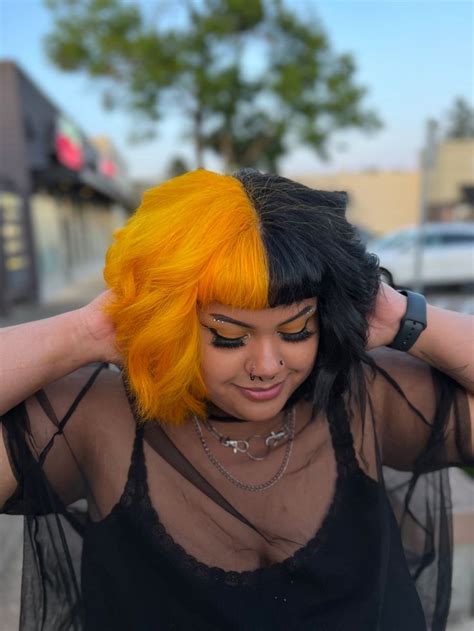Are you ready to turn heads with a statement-making hairstyle? Split dyed hair is a bold and vibrant hair trend that allows you to express your individuality and creativity. This eye-catching look involves dividing your hair into two or more sections and dyeing each section a different color.

The History of Split Dyed Hair
The origins of split dyed hair can be traced back to ancient times. Egyptian pharaohs wore wigs with intricate color patterns, and Japanese geishas traditionally dyed their hair black and red. In the 1970s, punk rockers embraced split dyed hair as a way to express their rebellion. Today, split dyed hair is popular among people of all ages and backgrounds who want to make a unique fashion statement.
Benefits of Split Dyed Hair
- Express your individuality: Split dyed hair allows you to showcase your unique personality and style.
- Make a bold statement: This hairstyle is guaranteed to turn heads and make a lasting impression.
- Experiment with color: Split dyed hair gives you the opportunity to experiment with different colors and create a look that is truly your own.
- Add depth and dimension: Split dyeing can add depth and dimension to your hair, making it look thicker and more voluminous.
- Create a temporary change: Split dyed hair is a great way to change your look without making a permanent commitment.
Types of Split Dyed Hair
There are endless possibilities when it comes to split dyed hair. Here are a few of the most popular variations:
- Horizontal split: The hair is divided horizontally, with one color on top and one on the bottom.
- Vertical split: The hair is divided vertically, with one color on one side and one on the other.
- Asymmetrical split: The hair is divided into two or more uneven sections, each with a different color.
- Hidden split: The hair is split dyed with a hidden layer of color underneath the top layer.
- Balayage split: The hair is split dyed using the balayage technique, which creates a subtle and natural-looking ombre effect.
How to Choose the Right Split Dyed Hair for You
Choosing the right split dyed hair for you depends on a number of factors, including your personal style, face shape, and hair type.
- Personal style: If you’re a bold and adventurous person, you might want to consider a bright and contrasting split dyed hair look. If you prefer a more subtle look, you might choose two similar colors or opt for a hidden split.
- Face shape: Split dyed hair can be used to flatter your face shape. If you have a round face, you might want to choose a vertical split with darker colors on the sides to slim down the face. If you have a long face, you might choose a horizontal split with lighter colors on the top to shorten the face.
- Hair type: Split dyed hair can be applied to all hair types, but it’s important to choose a color combination that will complement your hair texture and porosity. If you have fine hair, you might want to choose lighter colors that will add volume. If you have thick hair, you might choose darker colors that will weigh the hair down.
How to Care for Split Dyed Hair
Split dyed hair requires special care to keep it looking its best.
- Use color-safe shampoo and conditioner: Color-safe products will help to prevent the colors from fading.
- Avoid using hot tools: Heat can damage the hair and cause the colors to fade.
- Get regular trims: Regular trims will help to remove split ends and keep the hair healthy.
- Protect your hair from the sun: The sun’s UV rays can damage the hair and cause the colors to fade.
Troubleshooting Split Dyed Hair
If you’re experiencing any problems with your split dyed hair, here are a few troubleshooting tips:
- Colors are fading: This can be caused by using harsh shampoos and conditioners, using hot tools, or exposing the hair to the sun.
- Split ends: This can be caused by over-processing the hair, using hot tools, or not getting regular trims.
- Uneven color: This can be caused by not applying the color evenly, using the wrong color combination, or not processing the hair for long enough.
- Brassiness: This can be caused by using the wrong toner or not toning the hair often enough.
If you’re struggling to troubleshoot your split dyed hair problems, it’s always best to consult with a professional hairstylist.
